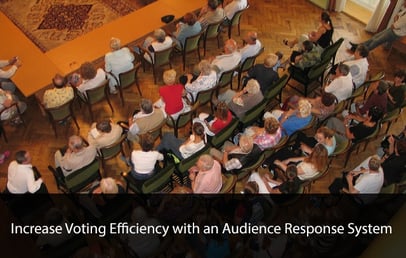
When a group or organization comes together for important decision-making tasks, group consensus is often a difficult and elusive outcome. Meeting facilitators must make sure the group members not only have the required information but also share their perspectives and collaborate on the issues involved in order to make the best decisions. Electronic voting with the use of wireless keypads and audience response software makes this decision process easier and more effective.
Electronic Voting is Fast... Traditional voting procedures require extensive time dedicated to the tallying and logging of votes. This not only increases the chance for error but also reduces the amount of time available to be spent on the actual topic being discussed.
Audience response systems, however, gather data from the audience every few seconds. An entire group of participants typically responds in about 20 seconds and results are tabulated immediately. There is no time wasted counting votes or tabulating results. After the meeting is over, electronic voting systems allow for an instant report of results that can be easily viewed and published immediately.
Electronic Voting is Private... There is no need for standing, speaking, or raising hands. Electronic voting maintains privacy and prevents anxiety and fear of reprisal when votes are disclosed.
Since electronic votes can be kept private, it also creates higher validity by ensuring that responses are more genuine and align with the true preferences of the voters in attendance as well as creating higher response and attendance rates.
Electronic Voting is Secure... Each vote is transmitted via encrypted wireless transmission and confirmed personally to each voter. Radio signals are encrypted using special proprietary radio chips and algorithms. Every transmission uses frequency hopping spread spectrum protocols that make the system very hard to hack.
Electronic Voting is Accurate... Electronic voting requires everyone in attendance to use voting keypads. These keypads each transmit a unique encrypted ID number associated with only one person. Each voter receives a confirming message.
Because these keypads will only count the last vote entered, they eliminate the chance of a person's vote being counted more than once. An electronic voting system can also reduce the potential for unauthorized votes that can occur in a standing vote count as well as eliminate the uncertainty of a close voice or hand vote and the result is unclear.
Some polling and voting software systems are even able to make use of web polling which allows anyone with a hand held browser-equipped device to participate without the need for interactive keypads. The system only requires you to use the browser on your device to navigate to a predesignated web address. This allows you to use your own smartphone, tablet, or notebook to participate from almost any location. In addition, the system automatically assigns an ID number to each connected device so that their responses are tracked and can be recorded separately from other connected devices.
Several hardware and software solutions for electronic voting are available for rent or purchase. ARS systems for electronic voting can scale from 10 people to as many as 15,000 participants in a single venue.
Click the button below to learn more about electronic voting!


